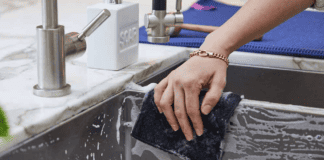Wood burning fireplaces are lovely. They’re so cozy on a wintery day or even during chilly fall and spring. I know in Toronto right now (where I live) while it’s technically spring the weather calls for a good fire.
The downside to wood fires is that they are soooo messy. And fireplace brick gets dirty-looking very quickly. I wouldn’t recommend deep cleaning the inside of the fireplace because it will get dirty immediately. Plus, this is a job best left to a professional chimney sweep (I can’t type that without wanting to watch Mary Poppins!), particularly when it comes to creosote. And if you don’t know what that is, I have a whole section on what is creosote later in this article.
What I do recommend is that you clean the exterior of your fireplace and surrounding areas. So today, we’re talking about how to clean brick fireplaces as well as the mantle and hearth. I recommend doing this periodically throughout the colder months if you use your fireplace often. But it’s also an excellent addition to your spring cleaning list.
If it’s cold where you live, consider checking out How to Wash a Winter Coat. If you’re reading this for spring cleaning inspo, be sure to also read The Best Spring Cleaning Checklist.

Fireplace Cleaning Maintenance
To avoid a huge mess when it comes time to deep clean your fireplace’s exterior, be sure to do a mini clean after each fire.
Let ashes and all fireplace remnants cool entirely before you begin. Your fireplace should be cool to the touch! This can take hours, so if you lit a fire in the evening, consider doing this mini clean the next morning.
Sweep the fireplace with your hearth broom. If you don’t have one, get one! You absolutely should not use your regular household broom for this job unless you want to get ashes all over your house.
Remnants of the fire, ash, wood, and everything else should be placed in a metal container, never plastic. And always do a dry clean of the fireplace because soot is very, very hard to clean once it’s wet.
What is Creosote?
Pay attention to creosote buildup, which can be harmful and dangerous. This flammable, greasy residue looks like brown or black tar, and it’s a normal byproduct of burning wood. However, exposure to large amounts of it can cause skin irritation, chemical burns, and even kidney and liver damage in extreme cases. Creosote buildup is also the cause of most chimney fires.
There’s no way to avoid it completely if you are burning wood, so it’s important to be cautious when cleaning your fireplace. And again, hire a chimney sweep once a year to clean out your internal fireplace and chimney to avoid a large amount of creosote buildup. Treat creosote like a harmful carcinogen, and don’t touch it! Luckily, you don’t have to worry too much about creosote on the outside of your fireplace.
How to Clean Fireplace Brick and Exterior
Sweeping the fireplace after each fire will make deep cleaning a whole lot easier. But it’s still a very messy job! Before you clean, lay plastic tarps down, ventilate the area well and wear clothes you are OK with getting very dirty. Then, make your DIY cleaning solution.
Mix one cup of dish soap, one cup of table salt (not kosher, not rock), and a half cup of ammonia to create a paste. If you want a thicker consistency, add more salt. Apply this paste to your fireplace brick (remember, only the external brick) and let it sit for 30 minutes. After the time has passed, use a stiff-bristled plastic brush to scrub well.
After you’ve scrubbed, rinse the whole area until the paste is gone. I like to do this using a bucket of clean, cool water and old rags. This is not a job for microfiber cloths because it’s a very messy cleaning job. The more often you do this, the less mess and work it will be.
Check your fireplace damper to make sure it’s free of buildup of creosote and other buildup by opening and closing it a few times. If there is a lot of friction or resistance or debris falls out, this indicates buildup.
Check your damper to make sure it’s free of creosote buildup by opening and closing it a few times. If there’s a lot of friction, it could indicate buildup; if debris falls out or there’s resistance, use a fireplace brush to loosen and clean.
Fireplace doors can be cleaned with equal parts white vinegar and water and a rag or paper towel. I don’t recommend anything fancy for cleaning here since the soot will leave stains behind. And finally, the flue can be cleaned with a chimney brush as needed.

Clean the Fireplace Mantle and Hearth
When it comes to the fireplace mantle and hearth, clean them using a vacuum dust brush. If you have a shop vac, you may wish to use this here instead of your regular household vacuum.
Use your vacuum attachment to get into all nooks and crannies of the stonework, the ledge of the mantle, the firebox, and the surrounding area. It’s a good idea to consider having one designated brush for this job, that way, you don’t have to worry about getting soot elsewhere in the house. I would suggest doing this pretty regularly to stay on top of soot and debris.
After vacuuming, use a dry cleaning sponge made for soot. Yep, there’s a sponge for pretty much everything! Use your sponge to wipe the surface. When that’s done, you can use water or all-purpose cleaner on a damp rag, but I would only do this if all the soot is gone, or else you’ll end up making another mess.
Bonus Fireplace Cleaning Tips
To keep your fireplace clean (well, as clean as possible), here are a few extra tips. While we all like to use old gift wrapping, magazines, junk mail, etc., as a fire starter, this isn’t a good idea. Color dyes can leave a flammable residue after burning. So stick to black and white newsprint or craft paper.
When it comes to wood, stay away from burning softwood logs (pine, fir, etc.) because this wood leaves resin behind, which is messier to clean. Plus, these kinds of wood contribute to higher creosote levels in your chimney and can be smokier when burnt.
How to Clean a Fireplace
There you have it. Cleaning the fireplace is a dirty job, maybe one of the dirtiest. And it can be dangerous if you don’t know what you’re doing. Always hire a chimney sweep to clean the flue, and do this annually if you use your fireplace.
For some, the mess of cleaning a fireplace isn’t worth having or using one. For others, it totally is. Let me know in the comments if you have a fireplace, how often you use it, or if you want a fireplace.
Looking for a BETTER & EASIER Way to Clean Your Home?
Cleaning Expert Melissa Maker is here to help with her game-changing 3 Wave Cleaning System that will help you clean your house faster and easier than you ever thought possible!
















